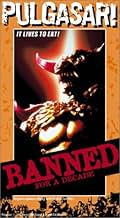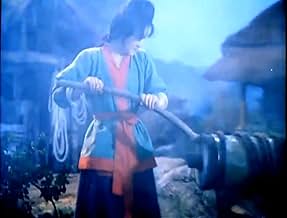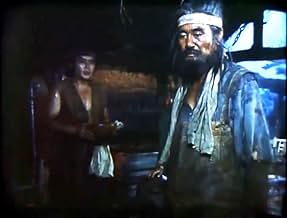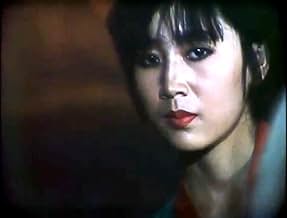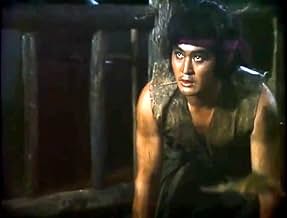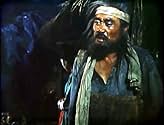Pulgasari
- 1985
- 1h 35m
IMDb RATING
5.2/10
1.5K
YOUR RATING
In feudal Korea, a group of starving villagers grow weary of the orders handed down to them by their controlling king and set out to use a deadly monster under their control to push his armi... Read allIn feudal Korea, a group of starving villagers grow weary of the orders handed down to them by their controlling king and set out to use a deadly monster under their control to push his armies back.In feudal Korea, a group of starving villagers grow weary of the orders handed down to them by their controlling king and set out to use a deadly monster under their control to push his armies back.
- Director
- Writer
- All cast & crew
- Production, box office & more at IMDbPro
Featured reviews
Since I began living in South Korea several years ago, I have always been curious about what life and art would be like in the isolated North. The educational channel in South Korea (EBS) has a weekly show that gives us clips of North Korean newscasts, movies, music, dramas and animation.
When South Korean president, Kim Dae-jung visited North Korea last year in the first step toward normalizing relations and possible (albeit future) unification, we learned that the North Korean supreme leader is something of a movie fanatic. He has been secretly receiving western movies and monitoring South Korean tv dramas. It is not surprising to learn that he apparently ordered Pulgasari be made. Like every other artform from the North it can only be broadcast or shown if it matches the philosophy of the state. Pulgasari is a metaphor. The evil king represents the feudal government of the Chosun Dynasty which ended at the beginning of the 1900's. The monster, Pulgasari represents capitalism. It arrives apparently to help the people, but soon grows out of control. The heroes in the movie are the peasantry, the common people who must fix everything that people with power have wrought.
Nobody can claim that Pulgasari is state-of-the-art. Even by rubber monster standards, this movies special effects are poor. It does help to consider that the budget for this movie was probably around what we spend on lunch in a year. But for me, the true fascination of a movie like this is the chance to see how another culture, living under a completely different philosophy, sees the world.
When South Korean president, Kim Dae-jung visited North Korea last year in the first step toward normalizing relations and possible (albeit future) unification, we learned that the North Korean supreme leader is something of a movie fanatic. He has been secretly receiving western movies and monitoring South Korean tv dramas. It is not surprising to learn that he apparently ordered Pulgasari be made. Like every other artform from the North it can only be broadcast or shown if it matches the philosophy of the state. Pulgasari is a metaphor. The evil king represents the feudal government of the Chosun Dynasty which ended at the beginning of the 1900's. The monster, Pulgasari represents capitalism. It arrives apparently to help the people, but soon grows out of control. The heroes in the movie are the peasantry, the common people who must fix everything that people with power have wrought.
Nobody can claim that Pulgasari is state-of-the-art. Even by rubber monster standards, this movies special effects are poor. It does help to consider that the budget for this movie was probably around what we spend on lunch in a year. But for me, the true fascination of a movie like this is the chance to see how another culture, living under a completely different philosophy, sees the world.
As the workers have a hard time rebelling against the oppressive (pre colonized) Chosen regime they get unexpected help from the gods. Bulgasari awakens to life from a figure of clay and rice with the drop of blood from Ami and is thereby under her authority. This secret weapon was exactly what they needed in order to kill the king, but it grows out of control. Whether this monster represents capitalism or not is anyones guess, I didn't notice anything that pointed towards that conclusion in the movie, but there's always the juche discourse to look it in the light of. After all Kim Jong-il is listed as a producer. With that in mind, I got a little bit anxious by the ending.
As a movie it is OK. The script is very simple and the characters are, like the weapons, like cardboard cutouts. Some of the berserker smashing the temples (cultural revolution style?) however, were quite impressive. All the shouting and wailing were not. I wonder if there's a movie were the title of it is repeated more often than in this.
As a movie it is OK. The script is very simple and the characters are, like the weapons, like cardboard cutouts. Some of the berserker smashing the temples (cultural revolution style?) however, were quite impressive. All the shouting and wailing were not. I wonder if there's a movie were the title of it is repeated more often than in this.
I like to watch Kaiju films and this Korean monster movie it's a funny monster movie with great battle scenes. In the beginning I supposed that will be other bad movie, but after some scenes you'll be invited to appreciate the story about poor villain people that fight against a bad king and his cruelty governor. Besides the poor special effects, most of them inside the atmosphere behind the Pulgarasi monster, other great battle scenes with hundred extras acting and fighting, You'll like all the crew efforth to create power and big scenes. This movie was produced by Jong-il Kim and directed by Sang-OK Shin. This is the first movie that I watch directed by Sang-OK Shin, but I felt interested in watch other movies directed by him.
PULGASARI is a hoot for lovers of demented, low budget cinema. It's the one and only North Korean kaiju movie out there, a film that's been inspired by the likes of GODZILLA and YONGGARY, although I think plot-wise it has most in common with the Japanese DAIMAJIN trilogy.
The story is a straightforward one in which the poor are presented as a righteous, oppressed people and an evil general and his army are the out-and-out villains. A humble blacksmith is captured and starved to death by the villains, but not before he's created Pulgasari, a tiny humanoid creature who eventually grows into a lovably, Baby Godzilla type beastie.
After a time, Pulgasari becomes the city-stomping giant monster that kaiju cinema loves, although given the budget there's little destruction on offer here and the effects are lacking to say the least. But the story with its uniquely North Korean slant is a solid one and the novelty value alone is enough to keep you watching. It's good fun!
The story is a straightforward one in which the poor are presented as a righteous, oppressed people and an evil general and his army are the out-and-out villains. A humble blacksmith is captured and starved to death by the villains, but not before he's created Pulgasari, a tiny humanoid creature who eventually grows into a lovably, Baby Godzilla type beastie.
After a time, Pulgasari becomes the city-stomping giant monster that kaiju cinema loves, although given the budget there's little destruction on offer here and the effects are lacking to say the least. But the story with its uniquely North Korean slant is a solid one and the novelty value alone is enough to keep you watching. It's good fun!
PULGASARI is a North Korean film, directed by an abducted South Korean. It's plot concerns villagers forced by their Overlord to turn all of their iron tools into weapons for the war effort. Instead, the villagers hide their tools, causing their oppressors to round them up.
Through supernatural means, the titular creature is conjured. To be honest, the story of the monster is interesting, as is its way of enlarging itself. The motive for the monster's arrival is completely different than in the original, lost film, BULGASARI. Here, instead of simple revenge, the monster arises in order to conquer the devilish king and his minions, for their oppression of the masses.
Fans of giant rubber monster movies should enjoy this one. There are also some big, human battle sequences. As with all such films, it takes quite a while before the monster really gets going.
This movie is also worth seeing for its historic and political value...
Through supernatural means, the titular creature is conjured. To be honest, the story of the monster is interesting, as is its way of enlarging itself. The motive for the monster's arrival is completely different than in the original, lost film, BULGASARI. Here, instead of simple revenge, the monster arises in order to conquer the devilish king and his minions, for their oppression of the masses.
Fans of giant rubber monster movies should enjoy this one. There are also some big, human battle sequences. As with all such films, it takes quite a while before the monster really gets going.
This movie is also worth seeing for its historic and political value...
Did you know
- TriviaAlthough the film is a North Korean production, director Shin Sang-ok is South Korean. North Korean dictator Jong-Il Kim was a huge fan of Shin's. At the time this film was made, North and South Korea were at war (which eventually ended in 2018 thanks to the Panmunjom Declaration). Thus, Kim had him kidnapped. Shin eventually escaped back to South Korea, but not before he had been forced to make this movie for the erratic North Korean leader.
- ConnectionsFeatured in Great Man and Cinema (2009)
- How long is Pulgasari?Powered by Alexa
Details
Contribute to this page
Suggest an edit or add missing content

